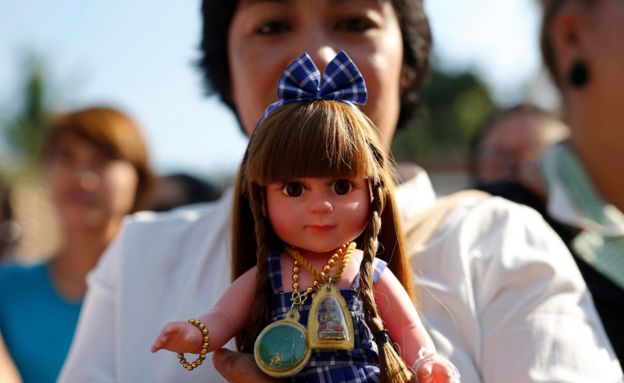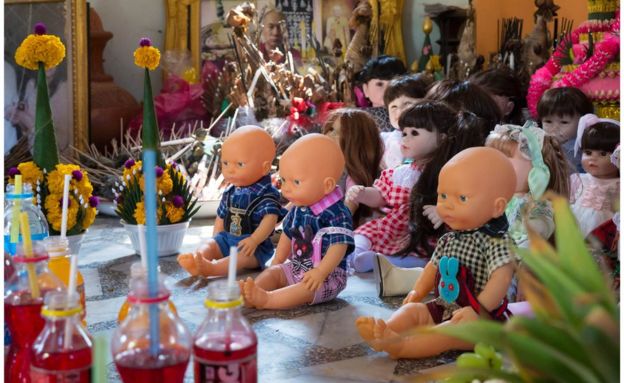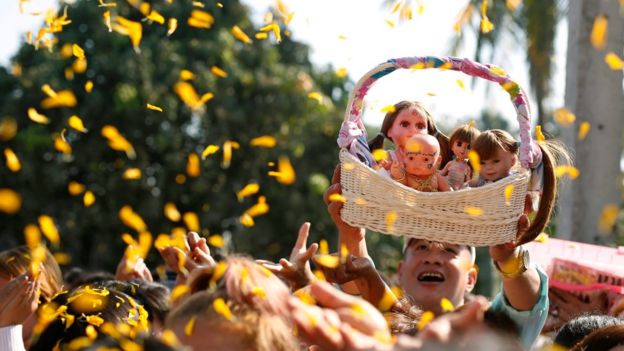Situated in the nondescript outer western suburbs of Bangkok, Sawang Arom temple is already well known for its collection of kuman - plastic child-dolls in historic costumes, usually clutching a bag of gold, and believed to be inhabited by the ghost of an unborn foetus.
People visit the temple throughout the day to pray to the kuman for good fortune, lighting incense sticks and kneeling before the garishly-coloured figures.
Some buy lottery tickets, and run their hands along the trunk of a fallen ironwood tree, festooned with coloured scarves and smoothed by years of handling. They believe they can see the winning number in the faded grain of the wood.
Thais, like many people in South East Asia, are superstitious. But the monks at the temple have found their doll collection growing recently, as people have quietly left behind child-sized figures, known as luk thep, or 'child angels'. The monks have moved them to a small room in a tower, where, like the kuman, they are served the red fizzy drinks they are believed to prefer.
"Each person has their own beliefs", one of the monks, Phra Prasit Warayan told me, "but the belief in the power of luk thep is very strong. When things go well for the owner, they worship them, but when things turn bad, they abandon them. Because they are afraid of what might happen, they leave them here, because they know we accept them, and the abbot is always careful to put them in an appropriate place."
The dolls look incongruous in the temple, in their formal children's clothing and with their wide-eyed, Western features. But how did the luk thep craze start? And is it just a continuation of the kuman belief, that inanimate objects can be inhabited by a ghost, or spirit?

 EPA
EPA
I hoped to find that answer at a dazzling pink house in a gated community in another suburb.
A chubby, blond doll's head sits on a shrine, next to offerings of food and water. Various other limbs lay drying outside after being given a special cream massage. In one room, two young women sat surrounded by different parts of doll's anatomies, carefully applying nail varnish, nose studs and weaving real human hair into soft, plastic scalps. The dolls are often given yantra - Buddhist tattoos - and are filled with rice, a symbol of prosperity.
In the next room Mananya Boonmi lovingly brushes the hair of her favourite doll, Pet. She has collected these dolls for fourteen years, but she did not always see them as she does now, as living beings, who will reward their owners with good fortune - as long as they are looked after as if they are a human child. She believes she was one of the earliest believers in luk thep.
She says she was selling small souvenirs around four years ago, when she had the feeling that one of her dolls, Ploy, was trying to help. She began to treat the doll like a real child, and her business took off. She says she was also able to overcome difficulties she was having raising her son.
"We can rely on luk thep mentally", she says. "They make us happy, as if they are alive, and we can carry them around with us. I love dressing them up, and talking to them. And if you look after them properly, they will come into your dreams."

The luk thep craze really took off last year when a few Thai celebrities were seen carrying their dolls with them everywhere, even to expensive restaurants or on flights. As they saw them as near-human, and felt they needed to treat them well to ensure good fortune, they refused to put the dolls in their check-in luggage or in the overhead compartment. They wanted to buy seats for them.
Last month the airline Thai Smile made headlines by allowing this. But there was a quick change of heart after a consultation with air safety officials. It turns out that the inanimate luk thep are luggage after all, and must be stowed as such. So Mananya says she will no longer fly.
Mananya now sells the dolls to customers for prices that can exceed $1,000. She holds ceremonies to impart a 'soul' into the dolls, but she does not feel this is the same as the spirit inhabiting kuman. Others have taken their dolls to Buddhist monks for blessings.
The belief in kuman thong, to give them their full name, dates back hundreds of years. In the old days, practitioners would try to obtain a real dead foetus, bake it dry, and then lacquer and gild it. It was believed to have very strong magical powers, but needed to be carefully fed and clothed.
There are striking similarities with the pampering some luk thep get, with wealthy owners giving their dolls botox injections or buying them jewellery.
 EPA
EPA
Professor Attachak Sattayanurak from Chiang Mai University sees strong parallels between the two kinds of dolls. He says that in Thailand there was a surge in demand for objects that might bring better luck in the chaos that followed the end of World War Two. Interest in the kuman tradition increased, although it was obviously necessary to find substitutes for a real foetus.
"More than 65% of Thai people work in the informal sector", he says. "Their lives are always uncertain. And recently the whole country has been going through a turbulent period. People are looking for comfort, for protection."
Nine years ago, when Thailand was also under military rule, I witnessed another sudden craze here. This was for an amulet called jatukam, which was first made by a police chief who claimed it had helped him solve difficult cases. Prices for the amulets, which were blessed by one temple in Southern Thailand, soared to astronomical levels.
At one point an image of the amulet was projected onto Thailand's tallest building. People ascribed all manner of powers to them. Then, just as suddenly, they lost interest, prices collapsed, and today they are more or less forgotten.
A similar fate may eventually await the luk thep dolls.
No comments:
Post a Comment